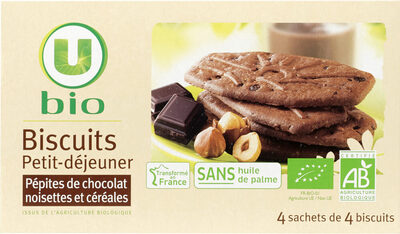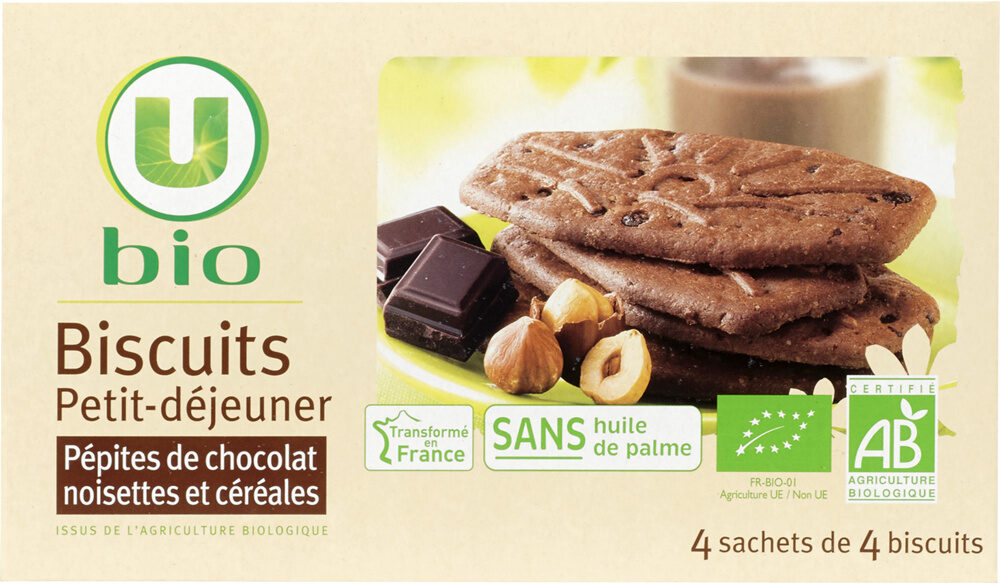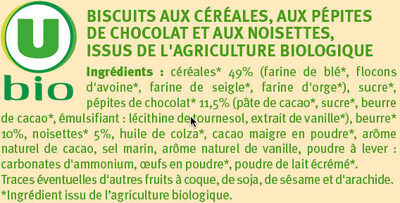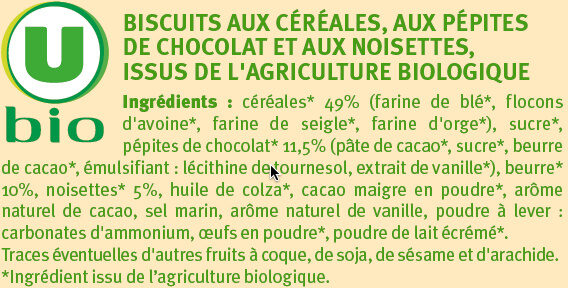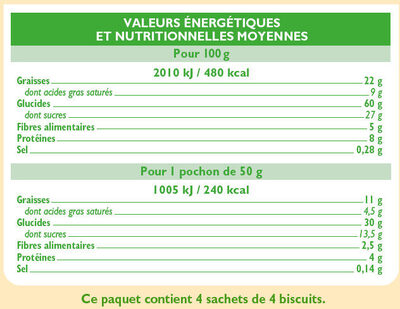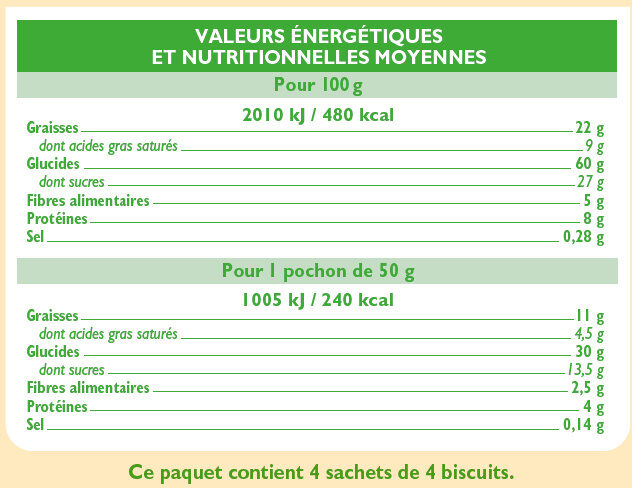Help us make food transparency the norm!
As a non-profit organization, we depend on your donations to continue informing consumers around the world about what they eat.
The food revolution starts with you!
Biscuits petit déjeuner pépites chocolat et noisettes - U Bio - de200 g
Biscuits petit déjeuner pépites chocolat et noisettes - U Bio - de200 g
This product page is not complete. You can help to complete it by editing it and adding more data from the photos we have, or by taking more photos using the app for Android or iPhone/iPad. Thank you!
×
Some of the data for this product has been provided directly by the manufacturer Système U.
Barcode: 3256223379387 (EAN / EAN-13)
Quantity: de200 g
Packaging: Plastic, Bag, Cardboard, Pack, Sleeve
Categories: Snacks, Breakfasts, Sweet snacks, Biscuits and cakes, Biscuits, Chocolate biscuits
Labels, certifications, awards:
Organic, EU Organic, Non-EU Agriculture, EU Agriculture, EU/non-EU Agriculture, FR-BIO-01, FSC, FSC Mix, No palm oil, Transformed in France, AB Agriculture Biologique


Stores: Magasins U, Utile, Super U
Countries where sold: France
Matching with your preferences
Health
Ingredients
-
22 ingredients
: Céréales* 47.5% (farine de BLE*, flocons d'AVOINE*, farine de SEIGLE*, farine d'ORGE*), sucre*, huile de colza, pépites de chocolat* 11.5% (sucre de canne*, pâte de cacao*, beurre de cacao*), NOISETTES* 5%, cacao maigre en poudre*, émulsifiant : lécithines de SOJA*, arôme naturel de cacao, sel marin, arôme naturel de vanille, poudre à lever : carbonates d'ammonium, OEUFS en poudre*, poudre de LAIT ÉCRÉMÉ*. Traces éventuelles d'autres fruits à coque, de soja, de graines de sésame et d'arachide. *ingrédient issu de l'agriculture biologique.Allergens: Eggs, Gluten, Milk, Nuts, SoybeansTraces: Nuts, Peanuts, Sesame seeds, Soybeans
Food processing
-
Ultra processed foods
Elements that indicate the product is in the 4 - Ultra processed food and drink products group:
- Additive: E322 - Lecithins
- Ingredient: Emulsifier
- Ingredient: Flavouring
Food products are classified into 4 groups according to their degree of processing:
- Unprocessed or minimally processed foods
- Processed culinary ingredients
- Processed foods
- Ultra processed foods
The determination of the group is based on the category of the product and on the ingredients it contains.
Additives
-
E322 - Lecithins
Lecithins are natural compounds commonly used in the food industry as emulsifiers and stabilizers.
Extracted from sources like soybeans and eggs, lecithins consist of phospholipids that enhance the mixing of oil and water, ensuring smooth textures in various products like chocolates, dressings, and baked goods.
They do not present any known health risks.
-
E322i - Lecithin
Lecithins are natural compounds commonly used in the food industry as emulsifiers and stabilizers.
Extracted from sources like soybeans and eggs, lecithins consist of phospholipids that enhance the mixing of oil and water, ensuring smooth textures in various products like chocolates, dressings, and baked goods.
They do not present any known health risks.
-
E503 - Ammonium carbonates
Ammonium carbonate: Ammonium carbonate is a salt with the chemical formula -NH4-2CO3. Since it readily degrades to gaseous ammonia and carbon dioxide upon heating, it is used as a leavening agent and also as smelling salt. It is also known as baker's ammonia and was a predecessor to the more modern leavening agents baking soda and baking powder. It is a component of what was formerly known as sal volatile and salt of hartshorn.Source: Wikipedia
Ingredients analysis
-
Palm oil free
No ingredients containing palm oil detected
-
Non-vegan
Non-vegan ingredients: Egg powder, Skimmed milk powder
-
Maybe vegetarian
Ingredients that may not be vegetarian: Natural cocoa flavouring
-
Details of the analysis of the ingredients
: Céréales 47.5% (farine de BLE, flocons d'AVOINE, farine de SEIGLE, farine d'ORGE), sucre, huile de colza, pépites de chocolat 11.5% (sucre de canne, pâte de cacao, beurre de cacao), NOISETTES 5%, cacao maigre en poudre, émulsifiant (lécithines de SOJA), arôme naturel de cacao, sel marin, arôme naturel de vanille, poudre à lever (carbonates d'ammonium), OEUFS en poudre, poudre de LAIT ÉCRÉMÉ- Céréales -> en:cereal - labels: en:organic - vegan: yes - vegetarian: yes - percent_min: 47.5 - percent: 47.5 - percent_max: 47.5
- farine de BLE -> en:wheat-flour - labels: en:organic - vegan: yes - vegetarian: yes - ciqual_proxy_food_code: 9410 - percent_min: 11.875 - percent_max: 47.5
- flocons d'AVOINE -> en:oat-flakes - labels: en:organic - vegan: yes - vegetarian: yes - ciqual_food_code: 9311 - percent_min: 0 - percent_max: 23.75
- farine de SEIGLE -> en:rye-flour - labels: en:organic - vegan: yes - vegetarian: yes - ciqual_proxy_food_code: 9532 - percent_min: 0 - percent_max: 15.8333333333333
- farine d'ORGE -> en:barley-flour - labels: en:organic - vegan: yes - vegetarian: yes - ciqual_food_code: 9550 - percent_min: 0 - percent_max: 11.875
- sucre -> en:sugar - labels: en:organic - vegan: yes - vegetarian: yes - ciqual_proxy_food_code: 31016 - percent_min: 11.5 - percent_max: 24.5
- huile de colza -> en:colza-oil - vegan: yes - vegetarian: yes - from_palm_oil: no - ciqual_food_code: 17130 - percent_min: 11.5 - percent_max: 24.5
- pépites de chocolat -> en:chocolate-chunk - labels: en:organic - vegan: maybe - vegetarian: yes - ciqual_proxy_food_code: 31005 - percent_min: 11.5 - percent: 11.5 - percent_max: 11.5
- sucre de canne -> en:cane-sugar - labels: en:organic - vegan: yes - vegetarian: yes - ciqual_proxy_food_code: 31016 - percent_min: 3.83333333333333 - percent_max: 11.5
- pâte de cacao -> en:cocoa-paste - labels: en:organic - vegan: yes - vegetarian: yes - ciqual_proxy_food_code: 16030 - percent_min: 0 - percent_max: 5.75
- beurre de cacao -> en:cocoa-butter - labels: en:organic - vegan: yes - vegetarian: yes - ciqual_food_code: 16030 - percent_min: 0 - percent_max: 3.83333333333333
- NOISETTES -> en:hazelnut - labels: en:organic - vegan: yes - vegetarian: yes - ciqual_food_code: 15004 - percent_min: 5 - percent: 5 - percent_max: 5
- cacao maigre en poudre -> en:fat-reduced-cocoa-powder - labels: en:organic - vegan: yes - vegetarian: yes - ciqual_food_code: 18100 - percent_min: 0 - percent_max: 5
- émulsifiant -> en:emulsifier - percent_min: 0 - percent_max: 5
- lécithines de SOJA -> en:soya-lecithin - labels: en:organic - vegan: yes - vegetarian: yes - ciqual_food_code: 42200 - percent_min: 0 - percent_max: 5
- arôme naturel de cacao -> en:natural-cocoa-flavouring - vegan: maybe - vegetarian: maybe - percent_min: 0 - percent_max: 4.08333333333333
- sel marin -> en:sea-salt - vegan: yes - vegetarian: yes - ciqual_food_code: 11082 - percent_min: 0 - percent_max: 0.27
- arôme naturel de vanille -> en:natural-vanilla-flavouring - vegan: yes - vegetarian: yes - percent_min: 0 - percent_max: 0.27
- poudre à lever -> en:raising-agent - percent_min: 0 - percent_max: 0.27
- carbonates d'ammonium -> en:e503 - vegan: yes - vegetarian: yes - percent_min: 0 - percent_max: 0.27
- OEUFS en poudre -> en:egg-powder - labels: en:organic - vegan: no - vegetarian: yes - ciqual_food_code: 22000 - percent_min: 0 - percent_max: 0.27
- poudre de LAIT ÉCRÉMÉ -> en:skimmed-milk-powder - labels: en:organic - vegan: no - vegetarian: yes - ciqual_food_code: 19054 - percent_min: 0 - percent_max: 0.27
- Céréales -> en:cereal - labels: en:organic - vegan: yes - vegetarian: yes - percent_min: 47.5 - percent: 47.5 - percent_max: 47.5
Nutrition
-
Average nutritional quality
⚠ ️Warning: the amount of fruits, vegetables and nuts is not specified on the label, it was estimated from the list of ingredients: 23This product is not considered a beverage for the calculation of the Nutri-Score.
Positive points: 5
- Proteins: 4 / 5 (value: 7.8, rounded value: 7.8)
- Fiber: 5 / 5 (value: 5, rounded value: 5)
- Fruits, vegetables, nuts, and colza/walnut/olive oils: 0 / 5 (value: 23, rounded value: 23)
Negative points: 14
- Energy: 5 / 10 (value: 2010, rounded value: 2010)
- Sugars: 5 / 10 (value: 26, rounded value: 26)
- Saturated fat: 3 / 10 (value: 4, rounded value: 4)
- Sodium: 1 / 10 (value: 108, rounded value: 108)
The points for proteins are not counted because the negative points are greater or equal to 11.
Nutritional score: (14 - 5)
Nutri-Score:
-
Nutrient levels
-
Fat in high quantity (23%)
What you need to know- A high consumption of fat, especially saturated fats, can raise cholesterol, which increases the risk of heart diseases.
Recommendation: Limit the consumption of fat and saturated fat- Choose products with lower fat and saturated fat content.
-
Saturated fat in moderate quantity (4%)
What you need to know- A high consumption of fat, especially saturated fats, can raise cholesterol, which increases the risk of heart diseases.
Recommendation: Limit the consumption of fat and saturated fat- Choose products with lower fat and saturated fat content.
-
Sugars in high quantity (26%)
What you need to know- A high consumption of sugar can cause weight gain and tooth decay. It also augments the risk of type 2 diabetes and cardio-vascular diseases.
Recommendation: Limit the consumption of sugar and sugary drinks- Sugary drinks (such as sodas, fruit beverages, and fruit juices and nectars) should be limited as much as possible (no more than 1 glass a day).
- Choose products with lower sugar content and reduce the consumption of products with added sugars.
-
Salt in low quantity (0.27%)
What you need to know- A high consumption of salt (or sodium) can cause raised blood pressure, which can increase the risk of heart disease and stroke.
- Many people who have high blood pressure do not know it, as there are often no symptoms.
- Most people consume too much salt (on average 9 to 12 grams per day), around twice the recommended maximum level of intake.
Recommendation: Limit the consumption of salt and salted food- Reduce the quantity of salt used when cooking, and don't salt again at the table.
- Limit the consumption of salty snacks and choose products with lower salt content.
-
-
Nutrition facts
Nutrition facts As sold
for 100 g / 100 mlAs sold
per serving (50g)Compared to: Chocolate biscuits Energy 2,010 kj
(480 kcal)1,010 kj
(240 kcal)-2% Fat 23 g 11.5 g -2% Saturated fat 4 g 2 g -66% Carbohydrates 58 g 29 g -6% Sugars 26 g 13 g -20% Fiber 5 g 2.5 g +47% Proteins 7.8 g 3.9 g +21% Salt 0.27 g 0.135 g -49% Fruits‚ vegetables‚ nuts and rapeseed‚ walnut and olive oils (estimate from ingredients list analysis) 23 % 23 %
Environment
-
Eco-Score C - Moderate environmental impact
⚠ ️Select a country in order to include the full impact of transportation.The Eco-Score is an experimental score that summarizes the environmental impacts of food products.→ The Eco-Score was initially developped for France and it is being extended to other European countries. The Eco-Score formula is subject to change as it is regularly improved to make it more precise and better suited to each country.Life cycle analysis
-
Average impact of products of the same category: C (Score: 56/100)
Category: Biscuit (cookie), with chocolate, prepacked
Category: Biscuit (cookie), with chocolate, prepacked
- PEF environmental score: 0.47 (the lower the score, the lower the impact)
- including impact on climate change: 5.92 kg CO2 eq/kg of product
Stage Impact Agriculture
63.6 %Processing
29.8 %Packaging
2.3 %Transportation
3.2 %Distribution
1.0 %Consumption
0.0 %
Bonuses and maluses
-
Labels with high environmental benefits
Bonus: +15
-
AB Agriculture Biologique
Organic agriculture contributes to preserve biodiversity, climate, water quality and soil fertility.
Organic food is food produced by methods complying with the standards of organic farming and features practices that cycle resources, promote ecological balance, and conserve biodiversity.
-
EU Organic
Organic agriculture contributes to preserve biodiversity, climate, water quality and soil fertility.
Organic food is food produced by methods complying with the standards of organic farming and features practices that cycle resources, promote ecological balance, and conserve biodiversity.
-
-
Missing origins of ingredients information
Malus: -5
⚠ ️ The origins of the ingredients of this product are not indicated.
If they are indicated on the packaging, you can modify the product sheet and add them.
If you are the manufacturer of this product, you can send us the information with our free platform for producers.
-
Packaging with a high impact
Malus: -15
Shape Material Recycling Impact Bag Plastic High Packet Cardboard Low Sleeve Unknown High Packet Unknown High ⚠ ️ The information about the packaging of this product is not sufficiently precise (exact shapes and materials of all components of the packaging).⚠ ️ For a more precise calculation of the Eco-Score, you can modify the product page and add them.
If you are the manufacturer of this product, you can send us the information with our free platform for producers.
Eco-Score for this product
-
Impact for this product: C (Score: 51/100)
Product: Biscuits petit déjeuner pépites chocolat et noisettes - U Bio - de200 g
Life cycle analysis score: 56
Sum of bonuses and maluses: -5
Final score: 51/100
-
Carbon footprint
-
Equal to driving 3.1 km in a petrol car
592 g CO² per 100g of product
The carbon emission figure comes from ADEME's Agribalyse database, for the category: Biscuit (cookie), with chocolate, prepacked (Source: ADEME Agribalyse Database)
Stage Impact Agriculture
52.9 %Processing
42.0 %Packaging
1.9 %Transportation
2.9 %Distribution
0.3 %Consumption
0.0 %
Packaging
-
Packaging with a high impact
-
Packaging parts
Bag (Plastic)
Packet (Cardboard)
Sleeve
Packet
-
Packaging materials
Material % Packaging weight Packaging weight per 100 g of product Paper or cardboard Plastic Total
-
Transportation
-
Origins of ingredients
Missing origins of ingredients information
⚠ ️ The origins of the ingredients of this product are not indicated.
If they are indicated on the packaging, you can modify the product sheet and add them.
If you are the manufacturer of this product, you can send us the information with our free platform for producers.Add the origins of ingredients for this product Add the origins of ingredients for this product
Labels
-
AB Agriculture Biologique
Organic agriculture contributes to preserve biodiversity, climate, water quality and soil fertility.
Organic food is food produced by methods complying with the standards of organic farming and features practices that cycle resources, promote ecological balance, and conserve biodiversity.
-
EU Organic
Organic agriculture contributes to preserve biodiversity, climate, water quality and soil fertility.
Organic food is food produced by methods complying with the standards of organic farming and features practices that cycle resources, promote ecological balance, and conserve biodiversity.
Report a problem
-
Incomplete or incorrect information?
Category, labels, ingredients, allergens, nutritional information, photos etc.
If the information does not match the information on the packaging, please complete or correct it. Open Food Facts is a collaborative database, and every contribution is useful for all.
Data sources
Product added on by openfoodfacts-contributors
Last edit of product page on by kiliweb.
Product page also edited by chalisi, desan, doc75, org-systeme-u, packbot, quechoisir, sebleouf, segundo, systeme-u, systeme-u-off, teolemon, virginie44360, yuka.VnBBT05Mc1FpdUEydjhRZytrejAxZFFyL0pTYmZYK1JLK3NxSVE9PQ, yuka.YllzalM0QWRoZHhVb2NZNnp5cmw0SUpTbHJLcGJXRHFEL3NMSWc9PQ.
